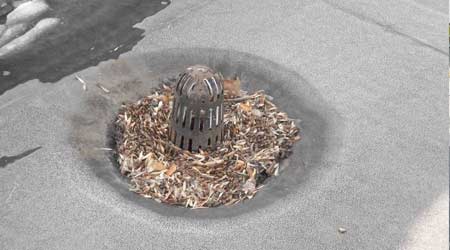 Regular inspections can prolong the life of a roof by identifying problems such as clogged gutters, which can lead to leaks below the roof and behind walls.Hoffmann Architects, Inc.
Regular inspections can prolong the life of a roof by identifying problems such as clogged gutters, which can lead to leaks below the roof and behind walls.Hoffmann Architects, Inc.Roofing Myths Busted: Inspections and Maintenance
How often should you do roof inspections? How frequently do new roofs require maintenance?
Myth: A warranty is the best protection
Warranties have an enticing allure, and they seem simple enough: You pay extra, and your roof is guaranteed not to leak. But what if it does? It might not be as easy as you would think to goad a manufacturer into sending an inspection team to look at the roof, much less fix it. And all too often, legal battles ensue while installation procedures are scrutinized to determine if all materials and methods fit the terms of the warranty agreement. Even if the manufacturer does perform warranty repairs, it’s possible that the same roofing system defect could fail again — and this time, it could do so outside the warranty coverage period.
The best guaranty of roofing durability is not an expensive warranty, but rather a roof system that is well designed, manufactured, and installed. Warranties are largely reactive, rather than proactive, and shouldn’t distract from proper specifications and application. Looking into the requirements for a long-term warranty, however, can bring to light potential weaknesses in a product or technology. For example, if the warranty requires extra provisions in installation procedures or details for certain areas, it would be prudent to pay special attention to those weak spots.
Myth: Gutters and drains are separate from the roofing system
Roofs must be designed to divert water from the structure. Drains prevent the ponding of water on the surface of the roof to avoid overloading the structure. Gutters and downspouts are similar, in that they transport water from the roof and away from the building’s facades and foundations. A roof’s drainage system must be properly designed and installed to prevent the damage and deterioration of the roof system and structure. In addition, it is vitally important that drains, gutters, and downspouts be cleaned regularly to prevent the back-up of debris and sediment. Clogged drains and gutters can result in leaks below the roof and behind walls.
Myth: New roofs do not require maintenance
The National Roofing Contractors Association (NRCA) recommends maintenance and repair be performed at least twice a year as well as before and after severe weather seasons and events. Typical maintenance includes removing debris from the roof, drains, and gutters, and repairing any damage to roof coverings and flashings. Failure to regularly inspect and maintain a roof can result in leaks, which may in turn void a warranty. Many warranties require yearly inspection and the regular performance of repairs to remain in effect.
Myth: Roof inspections are not required unless there are signs of damage or leaks
While that’s not an unreasonable approach, most building owners and facility managers will find that planning ahead for roof maintenance and replacement, and responding promptly to signs of deterioration, actually saves money and reduces downtime. By the time a leak is detected at the building interior, water has likely saturated insulation and damaged structural elements, framing, and drywall, to the point that repairing water damage can be more expensive than fixing the leak.
The best way to keep roofing costs under control is to inspect the structure frequently over the life of the roof. By catching little problems early and repairing them, building owners and facility managers can usually add many years of useful life to the structure.
Myth: There is no need to consider replacing a roof before it fails
Replacing an aging roof assembly before problems arise might seem an extravagance, but it can be fiscally responsible. Advance planning allows the prudent building owner or facility manager time to evaluate the available options, in order to make the best choice for the budget and the building’s needs. Emergency reroofing rarely affords that luxury.
With so much misinformation circulated about roofs, it can be a challenge to tell good advice from bad. Knowing when the time and effort spent on routine inspections, roof system evaluation, flashing and drainage maintenance, and other roof management tasks is worthwhile, or whether resources are better spent on other, more visible parts of the building, can be tough to assess. By taking a few minutes to consider roofing assumptions, building owners and facility managers will likely save resources in the long run, as many closely held notions about roofing are as wrong as they are damaging.
The straight talk on roofs is that there are no easy answers: The best way to prolong roof lifespan is to design appropriately, install correctly, and maintain diligently. And that’s no myth.
Erin Kesegi (e.kesegi@hoffarch.com), AIA, is senior architect at Hoffmann Architects, Inc., where she conducts comprehensive on-site investigations, oversees development of drawings and specifications, and provides construction administration services, as well as on-site project representation, for building envelope rehabilitation projects.
Related Topics:














